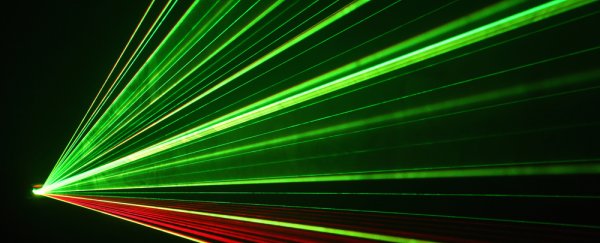A new experiment conducted by optical physicists at the University of Glasgow in Scotland presents evidence that light pulses can be slowed down by manipulating their spatial structure.
The results of the study were posted online at arXiv.org before being published in Science, and suggest that light speed should be considered a maximum limit, rather than an invariable speed applicable to all forms of light passing through free space.
"The slowing is not great, in our specific case 0.001 percent," principal investigator Miles Padgett told ScienceAlert. "But that it exists at all disagrees with a simple but wrong notion that we have that light always goes at the same speed."
"Previously people had recognised that the speed of light was complicated, but our experiment, which measures single photons, is perhaps the cleanest demonstration," he said.
The speed of light in a vacuum, referred to simply as c, is 299,792,458 metres per second.
It's a fundamental constant in physics: it defines the absolute speed limit for the transfer of energy, matter and information.
And if light displays any variance in this speed, it's usually due to an obstructing material, such as water, which has a greater refractive index than a vaccum (when lightwaves pass through water they bend and consequently slow down).
This is one of the reasons why the result is so interesting: the researchers have demonstrated, through repeated experiments, a very subtle invariance in the speed of photons travelling through the same vacuum medium.
"It's very impressive work," Robert Boyd, an optical physicist at the University of Rochester in New York, told Science News. "It's the sort of thing that's so obvious, you wonder why you didn't think of it first."
The researchers compared the speeds of two photons, which were identical except for an altered structure. One photon was sent through a fibre toward their detector, while the other was shot through, what the researchers call a "mask". This mask altered the structure of the photon, before redirecting it back to the detector.
As writer Andrew Grant explains for Science News: "Had structure not mattered, the two photons would have arrived at the same time. But that didn't happen. Measurements revealed that the structured light consistently arrived several micrometers late per meter of distance travelled."
Padgett told ScienceAlert that the length of the delay in arrival "depended upon the pattern of the mask" and said his team was able to predict the delay.
Theoretical papers have previously discussed the potential invariance of the speed of light in a vacuum, suggesting that the vacuum of space isn't exactly empty, but full of "virtual particles" like quarks, that capture and re-emit photons, altering their speed.
But this is the first time the invariable speed has been observed and tested.
"Beyond light, the effect observed will have applications to any wave theory, including sound waves and, potentially, gravitational waves," the authors write.
SOURCE: Science News
